Tulips paint spring gardens with an astonishing spectrum of colors that goes far beyond basic reds and yellows. According to botanist Dr. Sarah Chen, “Modern breeding has created over 150 distinct tulip shades and patterns.” The flowers now showcase rare combinations like green-streaked petals, near-black blooms, and sunset-gradient varieties. Understanding these color possibilities, their historical significance, and proper placement transforms ordinary gardens into masterpieces of natural artistry — but selecting the right combinations requires careful planning.
Contents
The Rich Legacy of Tulip Hues Throughout History

Though tulips have enchanted gardeners for centuries with their vivid colors, these beloved flowers first gained widespread recognition during the Dutch Golden Age of the 1600s. The tulip’s historical significance reached its peak during “Tulip Mania,” when rare varieties sold for astronomical prices due to their unique color patterns.
Throughout tulip history, breeders developed increasingly diverse hues through selective cultivation. Early varieties displayed simple reds and yellows, while modern hybridization has expanded the palette to include nearly every color except true blue. This rich legacy of color breeding continues today, with recent developments focusing on creating stable multicolor varieties that maintain their striking patterns year after year.
Breaking Down Popular Tulip Color Families
While tulips offer a vast spectrum of colors to choose from, understanding the main color families helps gardeners create cohesive and striking displays. Red varieties like ‘Van Eijk’ and ‘Red Proud’ deliver bold statements, while purple cultivars such as ‘Purple Flag’ add royal elegance. Current seasonal tulip trends favor tulip color combinations mixing pastels with deeper tones. Pink options range from delicate ‘Albert Heijn’ to vibrant ‘Design Impression’, while yellow and orange varieties provide cheerful accents. White tulips like ‘Purissima’ offer versatility, and multicolor selections including ‘Double Ice Cream’ create dramatic focal points in any garden design.
Symbolic Meanings Behind Your Favorite Tulip Colors

The language of tulip colors speaks volumes in gardens and floral arrangements, carrying deep symbolic meanings across cultures and traditions. Each hue creates unique emotional connections: red tulips represent passionate love, while purple varieties convey nobility and wealth. White blooms symbolize purity and sympathy, making them ideal for both weddings and memorial gardens.
Yellow tulips express friendship and joy, while pink varieties demonstrate caring and affection. Orange blooms represent enthusiasm and appreciation. These symbolic interpretations help gardeners select meaningful combinations for special occasions or to evoke specific sentiments in their landscape designs.
Creating Color Harmony With Tulip Varieties
Creating harmonious tulip color combinations requires understanding basic color theory principles and seasonal bloom timing. For classic color blending, pair complementary varieties like ‘Van Eijk’ red tulips with ‘Freeman’ yellow blooms, which flower simultaneously in mid-spring.
Seasonal combinations work best when grouping tulips with similar bloom periods. Plant early-spring ‘Albert Heijn’ pink tulips alongside ‘Purple Flag’ for striking contrast, or create peaceful monochromatic displays using white ‘Purissima’ with cream-colored ‘White Triumphator’.
For maximum visual impact, arrange tulips in groups of odd numbers, spacing bulbs 4-6 inches apart. Consider surrounding landscapes when selecting color schemes.
Best Practices for Color Selection in Tulip Gardens

Successful tulip garden design begins with three fundamental color selection principles that guide visual harmony and seasonal impact.
First, evaluate existing spring bloomers to create natural color contrast with tulip varieties. Second, consider architectural elements like brick or siding when choosing complementary tulip shades. Third, plan seasonal combinations by staggering early, mid, and late-blooming cultivars.
Expert landscapers recommend limiting color palettes to three main hues per garden section. “Group similar colors in clusters of 7-12 bulbs,” advises master gardener Sarah Thompson. “This creates visual impact while maintaining design cohesion throughout the blooming season.”
